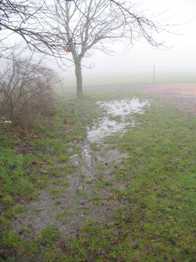
Habitat
 The Fossaria parva are considered a freshwater, semi
aquatic (sometimes referred to, loosely, as “amphibious”) snail
and tend to find small, sometimes temporary, pools of water in
which to reside. Many times the snail will favor uneven land
surfaces, where interim pools of water are most likely to
accumulate, and create hollows in which they will inhabit (Forsyth,
1957).
Some snails can be sensitive to the pH level of water when
deciding where to live. In a study done in Minnesota, it was
found that F. parva tend to inhabit in or around water
that is between pH level 5.2 through 6.5 and tend to live in
faster-moving water than the their lymnaeid counterparts (Averbeck,
1989).
When not in the water, F. parva will remain
nearby on land, usually on a moist surface such as a rock, log
or wet leaf near the water's edge (The
Skipper Project, 2011).
The Fossaria parva are considered a freshwater, semi
aquatic (sometimes referred to, loosely, as “amphibious”) snail
and tend to find small, sometimes temporary, pools of water in
which to reside. Many times the snail will favor uneven land
surfaces, where interim pools of water are most likely to
accumulate, and create hollows in which they will inhabit (Forsyth,
1957).
Some snails can be sensitive to the pH level of water when
deciding where to live. In a study done in Minnesota, it was
found that F. parva tend to inhabit in or around water
that is between pH level 5.2 through 6.5 and tend to live in
faster-moving water than the their lymnaeid counterparts (Averbeck,
1989).
When not in the water, F. parva will remain
nearby on land, usually on a moist surface such as a rock, log
or wet leaf near the water's edge (The
Skipper Project, 2011).
According to the online encyclopedia, Nature
Serve, the Fossaria parva is found in various locations
across North America. In the United States, the pygmy fossaria is
found in Arizona, Colorado, Connecticut, Iowa, Idaho, Illinois,
Indiana, Kansas, Kentucky, Maryland, Maine, Michigan, Minnesota,
Montana, New Mexico, New York, Ohio, Oklahoma, Pennsylvania, Texas,
Utah, Virginia, Wisconsin, and Washington. In Canada, this species
is also found in the following Provinces: British Colombia, Alberta,
Northwest Territories, Nunavut, Saskatchewan, Manitoba, Ontario and
Quebec. In most areas in which this snail dwells, the prevalence of
these animals are unknown and considered still
under review, meaning that conservationists are still in the
process of determining which areas the Fossaria parva are
in need of protection/conservation or not. There are some places,
however, in which numbers are known and different conservation
levels have been applied. Unfortunately, the pygmy fossaria is
considered vulnerable (meaning their
numbers are in danger of depleting) in New York and British
Colombia, imperiled (meaning few members
in the population remaining) in Connecticut and
critically imperiled (which means very few members remain in
the population) in Utah. On the other hand, the population of these
animals in Oklahoma, Virginia and Alberta are classified as
apparently
secure (their numbers show no
threat of depleting at this time) and secure
(their numbers are stable) in Colorado and Ontario. (Nature
Serve, 2010)
Below is a map depicting the distribution of the freshwater snail
Fossaria parva. The different colors represent
different conservation levels and correspond with the coloring in
the paragraph above.